AI-Assisted Alien Search Discovers 8 “Highly Unusual” Radio Signals
It’s estimated that the Universe contains hundreds of billions of galaxies, and each galaxy has about that many planets, so the chances of Earth being the only place with life are incredibly slim. A new AI system has now trawled through millions of radio signals from space to identify any potentially artificial in origin – and uncovered eight signals that look intriguingly alien.
If aliens scanned the earth with the right equipment, they would pick up our radio chatter and other electromagnetic signals we’ve been sending out for nearly a century. With this in mind, the Breakthrough Listen initiative aims to turn the tables and look for artificial radio signals coming from other planets in our galaxy. The team calls these signals “technosignatures”.
The problem is that the universe is a noisy place – stars, black holes, magnetars, quasars, FRBs, supernovae, gamma-ray bursts, and a whole host of other objects and events can generate radio and other signals. And then there’s all the interference from our own technology, like cell phones and GPS satellites. Blocking out the background noise to find possible alien technosignatures is a monumental task.
Or at least it is for humans. Artificial intelligence is adept at sorting through massive amounts of data to look for patterns, which means this is the perfect job of making it work. For the new study, University of Toronto student Peter Ma developed a new machine learning algorithm designed to filter out the most promising technosignature candidates.
The algorithm works according to a two-stage process. The first step involves an autoencoder being trained on simulated intelligent alien signals so it knows what to look for. In principle, it must be a narrow-band signal with a detectable drift rate and only occur when observing certain regions of the sky. These simulated signals are added to a pool of actual data until the autoencoder learns to recognize them reliably.
Once it can do that, the AI gets to the real work. Each signal in the dataset goes through an algorithm called the Random Forest Classifier, which separates the remarkable from the noise. In this case, the team fed more than 150 TB of data collected by the Green Bank Telescope (GBT) into the AI system.
From the 3 million signals in the dataset, the AI identified 20,515 signals of interest. The researchers then had to manually examine each of these signals – and interestingly, eight of these signals had the right properties to be technosignatures and could not be traced back to interference.
“Eight signals looked very suspicious, but after we looked at the targets again with our telescopes, we didn’t see them anymore,” Ma said. “It’s been almost five to six years since we took the data, but we still haven’t seen the signal again. Make of it what you want.”
As intriguing as the signals are, they fall far short of answering the most profound question of whether we are alone in the universe. The team acknowledges that we don’t know exactly what a real alien technosignature would look like, and using simulations could end up training the AI to focus on the wrong things.
Still, it’s a worthwhile exercise, and applying AI to other datasets could yield more possible technosignatures.
The research was published in the journal natural astronomy.
Sources: NVIDIA, Breakthrough Lists
Source: newatlas.com
Don’t miss interesting posts on Famousbio










